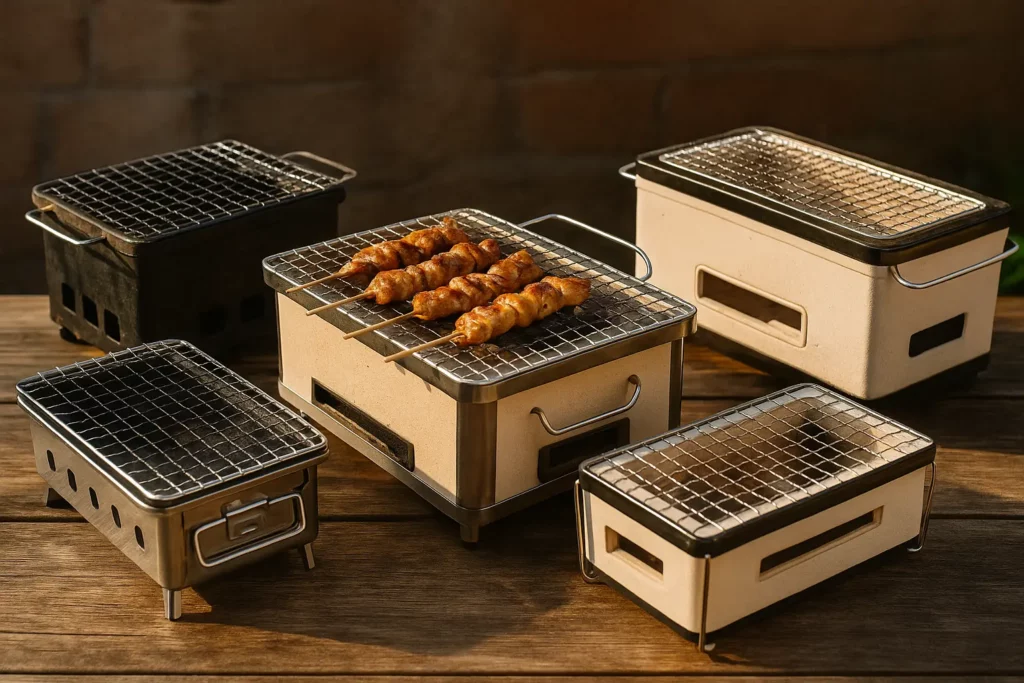This post may contain affiliate links. If you use these links to buy something we may earn a small commission. Thanks.
Yakitori skewered and grilled chicken is one of Japan’s most beloved street foods. Cooked over glowing binchotan charcoal, each bite is smoky, juicy, and bursting with umami. While yakitori is traditionally made at specialty stalls or izakaya bars in Japan, more and more people around the world are trying to recreate the experience at home.
But here’s the secret: the right grill makes all the difference. Yakitori requires even heat, proper airflow, and a compact surface that keeps skewers close to the flame without scorching. From classic Japanese charcoal grills to modern gas and electric options, the market now offers many choices to suit different needs.
This guide will explore the best yakitori grills available today whether you’re aiming for authentic binchotan grilling on your patio, a ceramic tabletop experience, or a convenient electric setup for indoor cooking.
What to Look for in a Yakitori Grill
Before we dive into the top picks, let’s cover what matters most when choosing a yakitori grill:
- Fuel Type
- Charcoal: The traditional choice, delivering smoky, authentic flavor. Works best with binchotan charcoal but can use regular lump charcoal too.
- Gas: Convenient, easier to manage heat, less mess, but lacks deep smoky flavor.
- Electric: Best for indoor use, compact and smoke-reduced, but flavor isn’t as rich.
- Size and Cooking Area
- Small tabletop grills are perfect for two to four people.
- Larger grills can handle multiple skewers for family gatherings or parties.
- Material
- Stainless steel for durability and easy cleaning.
- Ceramic or diatomaceous earth for excellent insulation and authentic Japanese design.
- Cast iron for heat retention, though heavy.
- Heat Distribution
- Even heat is essential for skewers that need frequent turning.
- Ease of Cleaning
- Removable ash trays, drip pans, and nonstick surfaces make cleanup simple.
- Portability
- Consider whether you’ll use it indoors, on patios, or bring it camping.

Best Yakitori Grills – Top Picks
Here are some of the best yakitori grills available today, with a mix of authentic Japanese models and practical alternatives.
1. Bincho Yakitori Charcoal Grill (Authentic Japanese Style)
- 🍢【Compact & Portable Design】The Bincho Grill 16" Mini is a lightweight Japanese grill that...
- 🍢【Durable Stainless Steel Build】Crafted with premium stainless steel, this Japanese charcoal...
- 🍢【Efficient Charcoal System】Features a thick aluminum charcoal box with stainless steel liner...
If authenticity is your priority, a bincho-style rectangular yakitori grill is the gold standard. These compact grills are designed specifically for skewers, with a narrow body that concentrates heat directly under the food.
- Best Use: Tabletop grilling with binchotan charcoal.
- Flavor: The open-air design gives skewers the signature smoky aroma found in Japanese izakayas.
- Pros:
- True authentic grilling experience.
- Compact and easy to fit on tables.
- Intense heat ideal for yakitori skewers.
- Cons:
- Small cooking area (best for 2–3 people).
- Requires specialty charcoal for best results.
This is the closest you’ll get to a Japanese street yakitori stall without hopping on a plane.
2. Fire Sense Large Yakitori Charcoal Grill
- FIRE SENSE LARGE YAKATORI CHARCOAL GRILL: Discover what the Japanese have recognized for centuries...
- The Large Yakatori Charcoal Grill is a genuine Japanese table BBQ. Handmade using clay, the Yakatori...
- FEATURES: Genuine Japanese table barbeque | Handmade clay construction | Adjustable ventilation |...
For those who want an affordable but authentic experience, the Fire Sense Large Yakitori Charcoal Grill is a popular choice. Made of ceramic clay, it retains heat impressively well, mimicking the qualities of high-end Japanese konro grills.
- Cooking Area: 17″ x 10″ rectangular surface.
- Features: Adjustable ventilation for airflow control, ceramic insulation, and wire cooking grate.
- Pros:
- Excellent heat retention.
- Affordable compared to imported Japanese grills.
- Large enough for multiple skewers at once.
- Cons:
- Ceramic body is fragile—needs careful handling.
- Not suited for heavy or rough use.
It’s a great starter yakitori grill for enthusiasts who want a taste of the real thing without a hefty price tag.
3. Konro Grill (Japanese Hibachi-Style)
- Shichirin style konro grill for cooking Japanese style grill at your home or restaurant. Perfect for...
- Grill comes with wire mesh grill that is easy to clean and wooden base to avoid direct contact with...
- Extremely portable and easy to assemble for grilling in home or restaurant use. Charcoal briquettes...
The konro grill is revered in Japan and used by professional yakitori chefs. These grills are made from diatomaceous earth, a material with incredible insulation properties. The result is a grill that burns extremely hot, ideal for achieving crispy edges and juicy centers on skewers.
- Cooking Area: Various sizes available, often 12–24 inches long.
- Best Charcoal: Binchotan (burns clean and hot).
- Pros:
- Professional-grade performance.
- Extremely efficient heat retention.
- Produces superior smoky flavor.
- Cons:
- Very expensive ($300–$600+).
- Heavy and not easily portable.
For serious yakitori lovers, the konro grill is the ultimate investment.
4. Weber Go-Anywhere Charcoal Grill (Yakitori Alternative)
- Holds up to six burgers made with a Weber burger press
- Compact and lightweight for grilling on the go
- Porcelain-enameled lid and base retain heat, and won’t rust or peel
While not a traditional yakitori grill, the Weber Go-Anywhere Charcoal Grill works surprisingly well for skewers. Its rectangular shape provides an even heat source, and the compact design makes it great for camping, picnics, or small patios.
- Cooking Area: 160 sq. in.
- Features: Locking lid and handles for portability.
- Pros:
- Affordable and widely available.
- Portable and durable.
- Versatile—works for more than just skewers.
- Cons:
- Not specialized for yakitori (skewer slots absent).
- Less heat intensity than Japanese-style grills.
If you want a budget-friendly option that can double as a yakitori grill, Weber delivers.
5. Indoor Electric Yakitori Grill (e.g., Zojirushi EB-CC15)
- NONSTICK: Large titanium and ceramic enhanced dual-layer nonstick grilling surface
- VERSATILE: Perfect for grilling steaks, seafood, vegetables, and more
- FEATURES: Grill design directs excess oils and fats away from food and into the drip pan for...
For apartment dwellers or anyone who can’t use charcoal, an indoor electric yakitori grill is a lifesaver. The Zojirushi model, for example, is a sleek countertop grill that delivers consistent heat without smoke overload.
- Cooking Area: Compact tabletop size.
- Features: Nonstick cooking surface, adjustable heat control, and drip pan.
- Pros:
- Can be used indoors safely.
- Easy to clean and maintain.
- Perfect for winter yakitori nights.
- Cons:
- Lacks authentic smoky charcoal flavor.
- Smaller cooking capacity.
This is the best choice for urban settings where open flames are off-limits.
6. Kinka BBQ Diatomite Charcoal Grill Barbecue Hibachi Stove
- Item Category: Barbecue Grill
- Item Trademark: Unknown
- manufacturer: Kinka
For convenience and portability, stainless steel gas yakitori grills are becoming popular. These grills often come with narrow skewer slots, designed to replicate traditional yakitori cooking while using propane instead of charcoal.
- Cooking Area: Medium-size, enough for 10–15 skewers.
- Features: Adjustable burners, quick ignition, easy cleanup.
- Pros:
- No ash or charcoal mess.
- Quick heat-up.
- Portable and efficient.
- Cons:
- Less authentic flavor compared to charcoal.
- Requires propane tank.
If you want hassle-free yakitori grilling at picnics or tailgates, a gas option is a smart pick.
Yakitori Grilling Tips
Getting the right grill is just step one—here are some expert tips to make your yakitori shine:
- Use Binchotan Charcoal (if possible): Burns hotter, cleaner, and longer than standard charcoal, giving yakitori its signature taste.
- Rotate Skewers Frequently: Yakitori needs attention. Rotate every minute or so for even browning.
- Avoid Overcrowding: Leave space between skewers to allow heat circulation.
- Prepare Tare Sauce: A traditional glaze of soy sauce, sake, mirin, and sugar that enhances flavor when brushed on skewers.
- Mix Cuts of Meat: Authentic yakitori uses a mix of thigh, skin, and even cartilage for varied textures.
Frequently Asked Questions
Q: Can I use a regular charcoal grill for yakitori?
Yes, a small charcoal grill works fine, though specialized yakitori grills provide better skewer placement and heat control.
Q: What’s the best charcoal for yakitori?
Binchotan is the gold standard—it burns clean and hot with minimal smoke. If that’s not available, lump charcoal is the next best option.
Q: Are electric yakitori grills worth it?
For indoor cooking, yes. They won’t give the same smoky flavor, but they’re convenient, easy to use, and safer in apartments.
Q: How do I clean a yakitori grill?
Wait for the grill to cool, remove ash (for charcoal models), wipe down surfaces, and wash grates with warm soapy water. Electric grills often come with removable drip trays.
Conclusion
Yakitori is as much about the cooking experience as it is about the food. Choosing the right grill can help you bring the authentic Japanese izakaya vibe to your home, patio, or even a camping trip.
- For authentic flavor, nothing beats a bincho-style or konro grill with binchotan charcoal.
- For budget-friendly entry, the Fire Sense Yakitori Grill or Weber Go-Anywhere are excellent choices.
- For indoor grilling, electric options like Zojirushi are practical and reliable.
- For convenience on the go, gas yakitori grills provide quick and easy results.
No matter which grill you choose, the joy of yakitori lies in sharing skewers hot off the grill with friends and family. With the right setup, you can recreate that authentic street-food experience anywhere.






